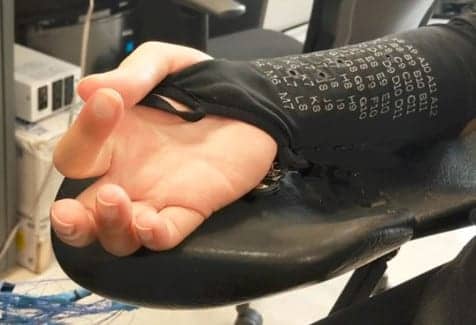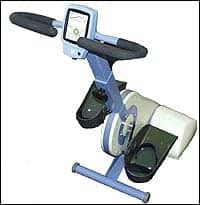
Researchers used an over-the-skin bioelectronic sleeve to help individuals with paralysis move their fingers. (Image courtesy of Northwell Health)
Researchers at The Feinstein Institutes for Medical Research used new closed-loop neurostimulation methods and textile-based electrodes to facilitate individual finger movement and grasp force regulation in quadriplegia individuals. Their study appears in Bioelectronic Medicine.
Over-the-skin, or transcutaneous, neuromuscular electrical stimulation is often used in physical rehabilitation for those with paralysis. However, there are limitations for non-invasive stimulation systems, including not being able to target all muscles, muscle fatigue and inconsistent contraction strength.
To address the current rehabilitative boundaries, a team of researchers, led by Chad Bouton, vice president of advanced engineering and professor in the Institute of Bioelectronic Medicine, partnered with Milad Alizadeh-Meghrazi, director of research and development at Myant Inc and co-author of the paper.
The team developed closed-loop neurostimulation methods and textile-based electrodes using proprietary processes from Myant Inc to form a lightweight, wearable sleeve that regulates individual finger forces to facilitate functional movement in paralyzed individuals, a media release from Northwell Health explains.
“We developed an approach that accurately controls muscle contractions and resulting forces exerted by the fingers,” Bouton says. “This opens up future research possibilities to create portable, rehabilitative devices beyond the laboratory to help those living with paralysis.”
The study consisted of three able-body participants and two participants with quadriplegia. The participants had the sleeve placed on their forearm, and electrical stimulation was applied to the different electrodes to evoke various movements. Finger extension, flexing, and a cylindrical type grasp was observed in each participant, including the ability to squeeze and support a full (750 mL) water bottle.
The results show that through controlled electrical stimulation, along with the use of lightweight textile electrodes, grasp force can be initiated and regulated in quadriplegia. In the future, the methods and technology used could be implemented with an in-brain computer interface to better decode and control hand movements, the release continues.
[Source(s): Northwell Health, PR Newswire]




